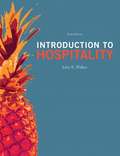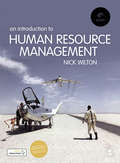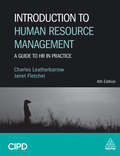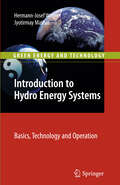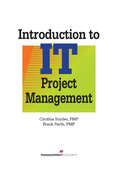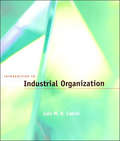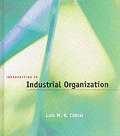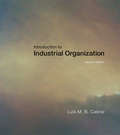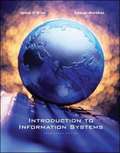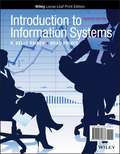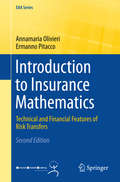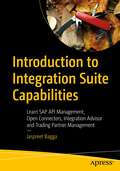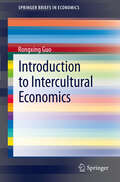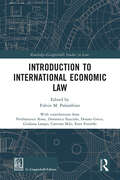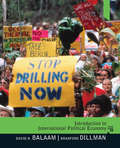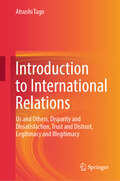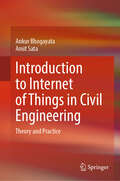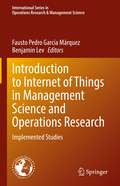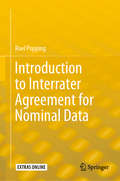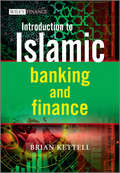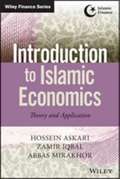- Table View
- List View
Introduction to Hospitality (6th edition)
by John R. WalkerThe Sixth Edition of Introduction to Hospitality focuses on hospitality operations while offering a broad, comprehensive foundation of current knowledge about the world's largest industry. The text is organized into five sections: the hospitality industry and tourism; lodging; restaurants, managed services, and beverages; recreation, theme parks, clubs, and gaming entertainment; and assemblies and event management.
Introduction to Hospitality (Seventh Edition)
by John R. WalkerPrepares students to succeed in any area of the hospitality industry. Introduction to Hospitality, 7/e, focuses on hospitality operations while offering a broad, comprehensive view of the world’s largest industry. The text is organized into four sections: hospitality and lodging; beverages, restaurants, and managed services; tourism, recreation, attractions, clubs, and gaming; and assemblies, events, attractions, leadership, and management. Each section includes real-world profiles, first-hand accounts, and engaging case studies to help readers connect with the material and foster an appreciation of the industry’s unique enthusiasm and passion. New photos, page layouts, and hands-on examples help students understand the how-to aspects of today’s hospitality industry. Updated to reflect today’s trends and realities, the Seventh Edition contains new coverage of spas, updated and new corporate profiles, salary information, hospitality-related technologies, and more!
Introduction to Human Resource Management
by Nick WiltonReflecting the global nature of the workplace with its use of real world examples and case studies, the book goes beyond a prescriptive approach in the practice of strategic HRM, and offers a concise introduction that encourages critical reflection. The NEW fourth edition includes: Discussions on employee engagement, the role and benefits of social media, and the impact of culture and global mobility The latest surveys and research and recent case studies and examples from a cross section industries and global companies, such as Zurich Insurance, Uber, Adobe, Deloitte and Netflix. A FREE interactive eBook giving students digital access to all the content as well as author videos, case studies, web-links, journal articles and quizzes. Lecturers can also access PowerPoint slides, teaching videos, a testbank and an Instructor's Manual.
Introduction to Human Resource Management
by Nick WiltonReflecting the global nature of the workplace with its use of real world examples and case studies, the book goes beyond a prescriptive approach in the practice of strategic HRM, and offers a concise introduction that encourages critical reflection. The NEW fourth edition includes: Discussions on employee engagement, the role and benefits of social media, and the impact of culture and global mobility The latest surveys and research and recent case studies and examples from a cross section industries and global companies, such as Zurich Insurance, Uber, Adobe, Deloitte and Netflix. A FREE interactive eBook giving students digital access to all the content as well as author videos, case studies, web-links, journal articles and quizzes. Lecturers can also access PowerPoint slides, teaching videos, a testbank and an Instructor's Manual.
Introduction to Human Resource Management: A Guide to HR in Practice
by Janet Fletcher Charles LeatherbarrowIntroduction to Human Resource Management is a comprehensive and accessible guide to the subject of HRM. Drawing on the authors' experiences in both the public and private sectors, and underpinned by academic theory, this textbook follows the logical sequence of the employment cycle and shows how human resource management plays out in practice. It covers organizational culture, the role of the HR professional, HR planning, recruitment and selection, talent management, L&D, motivation and performance, health and safety, diversity and equality, employment law, change management and handling and managing information.With a range of pedagogical features, including contemporary case studies and review questions, Introduction to Human Resource Management maps to the CIPD Level 3 Foundation Certificate in HR Practice and is also ideal for foundation and undergraduate students encountering HRM for the first time. This fully updated 4th edition has been revised and expanded to include coverage of zero-hours contracts and the gig economy, social media and e-recruitment and the UK apprenticeship levy. Online supporting resources include an instructor's manual, lecture slides and students' resources including multiple choice questions, additional case studies and reflective questions for self-study.
Introduction to Hydro Energy Systems: Basics, Technology and Operation
by Hermann-Josef Wagner Jyotirmay MathurThe authors have tried to strike a balance between a short book chapter and a very detailed book for subject experts. There are three prime reasons behind for doing so: first, the field is quite interdisciplinary and requires simplified presentation for a person from non-parent discipline. The second reason for this short-version of a full book is that both the authors have seen students and technically oriented people, who were searching for this type of book on hydro energy. The third reason and motivation was considering engineers who are starting their career in hydro energy sector. This book is targeted to present a good starting background and basic understanding for such professionals.
Introduction to IT Project Management
by Cynthia Snyder PMP Frank Parth PMPIntroduction to IT Project Management provides IT project managers the practical tools needed to maintain daily operations while managing multiple projects. This valuable reference helps IT project managers, CIOs, and project sponsors understand the IT project environment so that projects can be managed much more efficiently and successfully. An instructor's guide is available.
Introduction to Industrial Organization
by Luis M. CabralThis book provides an issue-driven introduction to industrial organization. Over the past twenty years, the study of industrial organization—the analysis of imperfectly competitive markets—has grown from a niche area of microeconomics to a key component of economics and of related disciplines such as finance, strategy, and marketing. This book provides an issue-driven introduction to industrial organization. It includes a vast array of examples, from both within and outside the United States. While formal in its approach, the book is written in a way that requires only basic mathematical training. Supplemental materials posted on the Web make more extensive use of algebra and calculus.
Introduction to Industrial Organization
by Luís M. B. CabralOver the past twenty years, the study of industrial organization--the analysis of imperfectly competitive markets--has grown from a niche area of microeconomics to a key component of economics and of related disciplines such as finance, strategy, and marketing. This book provides an issue-driven introduction to industrial organization. It includes a vast array of examples, from both within and outside the United States. While formal in its approach, the book is written in a way that requires only basic mathematical training. Supplemental materials posted on the Web make more extensive use of algebra and calculus.
Introduction to Industrial Organization, second edition
by Luis M. CabralAn issue-driven introduction to industrial organization, thoroughly updated and revised.The study of industrial organization (IO)—the analysis of the way firms compete with one another—has become a key component of economics and of such related disciplines as finance, strategy, and marketing. This book provides an issue-driven introduction to industrial organization. Although formal in its approach, it is written in a way that requires only basic mathematical training. It includes a vast array of examples, from both within and outside the United States. This second edition has been thoroughly updated and revised. In addition to updated examples, this edition presents a more systematic treatment of public policy implications. It features added advanced sections, with analytical treatment of ideas previously presented verbally; and exercises, which allow for a deeper and more formal understanding of each topic. The new edition also includes an introduction to such empirical methods as demand estimation and equilibrium identification. Supplemental material is available online.
Introduction to Information Systems (14th edition)
by James A. O'Brien George M. MarakasO'Brien's Introduction to Information Systems 14e continues to reflect the movement toward enterprise-wide business applications. George Marakas from the University of Kansas joins as a co-author on this new edition. New real world case studies correspond with this curriculum shift. The texts focus is on teaching the general business manager how to use and manage the most current IT technologies such as the Internet, Intranets, and Extranets for enterprise collaboration, and how IT contributes to competitive advantage, re-engineering business processes, problem solving, and decision-making.
Introduction to Information Systems: Seventh Edition
by R. Kelly Rainer Casey G. CegielskiThe goal of Introduction to Information Systems is to teach undergraduate business majors how to use information technology to master their current or future jobs. Students develop a working understanding of information systems and information technology and learn how to apply concepts to successfully facilitate business processes. This product demonstrates that IT is a key component of any business, whether a student is majoring in Accounting, Finance, Marketing, Human Resources, or Production/Operations Management.
Introduction to Insurance Mathematics
by Ermanno Pitacco Annamaria OlivieriThis second edition expands the first chapters, which focus on the approach to risk management issues discussed in the first edition, to offer readers a better understanding of the risk management process and the relevant quantitative phases. In the following chapters the book examines life insurance, non-life insurance and pension plans, presenting the technical and financial aspects of risk transfers and insurance without the use of complex mathematical tools. The book is written in a comprehensible style making it easily accessible to advanced undergraduate and graduate students in Economics, Business and Finance, as well as undergraduate students in Mathematics who intend starting on an actuarial qualification path. With the systematic inclusion of practical topics, professionals will find this text useful when working in insurance and pension related areas, where investments, risk analysis and financial reporting play a major role.
Introduction to Integration Suite Capabilities: Learn SAP API Management, Open Connectors, Integration Advisor and Trading Partner Management
by Jaspreet BaggaDiscover the power of SAP Integration Suite's capabilities with this hands-on guide. Learn how this integration platform (iPaaS) can help you connect and automate your business processes with integrations, connectors, APIs, and best practices for a faster ROI. Over the course of this book, you will explore the powerful capabilities of SAP Integration Suite, including API Management, Open Connectors, Integration Advisor, Trading Partner Management, Migration Assessment, and Integration Assessment. With detailed explanations and real-world examples, this book is the perfect resource for anyone looking to unlock the full potential of SAP Integration Suite. With each chapter, you'll gain a greater understanding of why SAP Integration Suite can be the proverbial swiss army knife in your toolkit to design and develop enterprise integration scenarios, offering simplified integration, security, and governance for your applications. Author Jaspreet Bagga demonstrates how to create, publish, and monitor APIs with SAP API Management, and how to use its features to enhance your API lifecycle. He also provides a detailed walkthrough of how other capabilities of SAP Integration Suite can streamline your connectivity, design, development, and architecture methodology with a tool-based approach completely managed by SAP. Whether you are a developer, an architect, or a business user, this book will help you unlock the potential of SAP's Integration Suite platform, API Management, and accelerate your digital transformation. What You Will Learn Understand what APIs are, what they are used for, and why they are crucial for building effective and reliable applicationsGain an understanding of SAP Integration Suite's features and benefits Study SAP Integration assessment process, patterns, and much moreExplore tools and capabilities other than the Cloud Integration that address the full value chain of the enterprise integration components Who This Book Is For Web developers and application leads who want to learn SAP API Management.
Introduction to Intercultural Economics
by Rongxing GuoThis book presents a methodological framework for the analysis of intercultural issues frequently misinterpreted by existing theories. It uses a challenge-and-response theory of cultural development to examine the relationship between different natural disasters and threats and the developments of ancient civilizations. The spatial interaction of ancient civilizations is assessed; and four non-linear patterns of intercultural dynamics are presented. Our empirical analyses of the four major ancient civilizations (the Mesopotamian, the Egyptian, the Indus, and the Chinese) focus on intercultural influences as well as how they have shaped the spatial dynamics of the world as a whole. This book also examines various aspects of intercultural economic influences, such as those of culture on international trade. Evidence from a broad panel of nations supports the presumption that high-income trade partners will be less sensitive to the measures of cultural dissimilarity than low-income trade partners between which cultural dissimilarity leads to barriers to international trade. The treatment of linguistic and religious factors as continuous variables in this book has improved past studies in which 'language' was treated as one or more dummy variables and 'religion' was ignored.
Introduction to International Economic Law (Routledge-Giappichelli Studies in Law)
by Donato Greco Pierfrancesco Rossi Caterina Milo Domenico Pauciulo Giuliana Lampo Ester FerrielloInternational Economic Law (IEL) refers to the rules governing economic relations at the international level and involving States, international organizations and private entities. This textbook explores IEL within the broader context of public international law from the ground up, providing all the foundational principles of international law essential for the study of IEL. The first part of the book is devoted to the analysis of actors and sources of IEL while the second part focuses on the three main sectors of IEL: international investment law, the law of international trade, as developed through the work of the World Trade Organization (WTO), and international financial and monetary law. Through references to conventional rules, landmark cases and decisions of international organizations, Introduction to International Economic Law provides a clear and concise primer on the main issues in current IEL. It will be an ideal textbook for students taking introductory courses in IEL, as well as a useful guide for anyone wishing to learn about the subject and understand the dynamics behind it.
Introduction to International Economics (Third Edition)
by Dominick SalvatoreThe aim of this text is to provide the student with an introduction to the field of international economics using many real-world case studies.
Introduction to International Political Economy
by David N. Balaam Bradford DillmanA complete and accessible overview of how politics and economics collide in a global context This text surveys the theories, institutions, and relationships that characterize IPE and highlights them in a diverse range of regional and transnational issues. The bestseller in the field, Introduction to International Political Economy positions students to critically evaluate the global economy and to appreciate the personal impact of political, economic, and social forces.
Introduction to International Relations: Us and Others, Disparity and Dissatisfaction, Trust and Distrust, Legitimacy and Illegitimacy
by Atsushi TagoThis textbook provides a comprehensive introduction for individuals who are new to the discipline of International Relations or World Politics. It features three distinctive elements. First, it posits that understanding the international political economy is essential before delving into analyses of war and security, emphasizing that economic interdependence, arising from international cooperation, is a central theme in international relations. Second, the textbook recognizes that strategic interaction — where the decisions of one entity and future outcomes depend on the choices of another — is a core component of international relations. It also utilizes four key concepts in its exploration of the field: Us and Others, Disparity and Dissatisfaction, Trust and Distrust, and Legitimacy and Illegitimacy. Lastly, the textbook is attuned to the methodologies of the Social Sciences, including descriptive, causal, and deductive inferences, and it stands out for its commitment to fostering methodological awareness.
Introduction to Internet of Things in Civil Engineering: Theory and Practice
by Ankur Bhogayata Amit SataThis textbook provides introductory concepts of the Internet of Things (IoT) in a concise and clear format. It presents in-depth information on the technological transformations and attributes of IoT. It also presents various examples of the applications of IoT in the field of civil engineering, both in laboratories and in the field. Various self-explanatory illustrations, figures, photographs and numerical details are included for a better understanding of concepts. A summary of contents and a list of review questions are provided at the end of each section for self-evaluation of the learnings from each chapter. A dedicated chapter for teachers is also provided which discusses pedagogy and curriculum development for the emerging field of IoT with reference to civil engineering education. The book also suggests methods of utilisation and integration of IoT concepts in education through assignments, tutorials, project works and research topics. This book is a valuable learning resource for undergraduate civil engineering students with limited exposure to computer science and engineering. It also functions as a reference resource for postgraduate students and scholars dealing with the application of IoT in civil engineering.
Introduction to Internet of Things in Management Science and Operations Research: Implemented Studies (International Series in Operations Research & Management Science #311)
by Fausto Pedro García Márquez Benjamin LevThis book aims to provide relevant theoretical frameworks and the latest empirical research findings in Internet of Things (IoT) in Management Science and Operations Research. It starts with basic concept and present cases, applications, theory, and potential future. The contributed chapters to the book cover wide array of topics as space permits. Examples are from smart industry; city; transportation; home and smart devices. They present future applications, trends, and potential future of this new discipline. Specifically, this book provides an interface between the main disciplines of engineering/technology and the organizational, administrative, and planning capabilities of managing IoT. This book deals with the implementation of latest IoT research findings in practice at the global economy level, at networks and organizations, at teams and work groups and, finally, IoT at the level of players in the networked environments. This book is intended for professionals in the field of engineering, information science, mathematics, economics, and researchers who wish to develop new skills in IoT, or who employ the IoT discipline as part of their work. It will improve their understanding of the strategic role of IoT at various levels of the information and knowledge organization. The book is complemented by a second volume of the same editors with practical cases.
Introduction to Interrater Agreement for Nominal Data (SpringerBriefs in Statistics)
by Roel PoppingThis introductory book enables researchers and students of all backgrounds to compute interrater agreements for nominal data. It presents an overview of available indices, requirements, and steps to be taken in a research project with regard to reliability, preceded by agreement. The book explains the importance of computing the interrater agreement and how to calculate the corresponding indices. Furthermore, it discusses current views on chance expected agreement and problems related to different research situations, so as to help the reader consider what must be taken into account in order to achieve a proper use of the indices.The book offers a practical guide for researchers, Ph.D. and master students, including those without any previous training in statistics (such as in sociology, psychology or medicine), as well as policymakers who have to make decisions based on research outcomes in which these types of indices are used.
Introduction to Islamic Banking and Finance
by Brian KettellIntroduction to Islamic Banking and Finance is a succinct guide to the key characteristics of Islamic banking highlighting how these differ from conventional banking. This detailed book illustrates how Islamic banking is consistent with the Sharia'a, a key element of which is the prohibition on collecting and paying interest. This central religious precept appears to rule out most aspects of modern finance but it does allow money to be used for trading tangible assets and business, which can then generate a profit. Brian Kettell's book looks at all aspects of Islamic banking, including chapters on its creation and evolution through to detailed discussions of the issues involved in the Sharia'a contracts of Murabaha, Mudaraba, Musharaka, Ijara, Istisna'a, and Salam. Islamic insurance (Takaful) is also covered. Finally the book takes a look at Sharia'a law and Sharia'a boards, indicating the roles and responsibilities that come with membership.Islamic banks have been operating in places such as Bahrain, Saudi Arabia, Malaysia and Dubai for some time. Conventional bankers have traditionally viewed the sector as a small, exotic niche but recent years have seen a dramatic surge in popularity. A number of Western investment banks have started working with Muslim clerics to create new ranges of financial products designed for devout Muslims, a large and growing market. Although estimates of the size of the Islamic finance industry vary greatly, everyone agrees that it is expanding rapidly and this is the perfect book for anyone looking to understand the industry.
Introduction to Islamic Economics
by Abbas Mirakhor Zamir Iqbal Hossein AskariGain deeper insight into the principles and theory of Islamic economicsIntroduction to Islamic Economics: Theory and Application provides an overview of the organizing principles and fundamentals of an Islamic economy. With deep discussion of the characteristics, rationale, key institutions, objectives, and instruments at work, the book addresses the core economic principles underlying a system based on the foundational teachings of Islam, and examines the implications for economic policies. Social welfare, economic justice, market functionality, efficiency, and equity are explored from an Islamic perspective, and the role and instruments of fiscal and monetary policy in Islamic systems are used to illustrate contemporary applications.Universities around the globe are offering courses on Islamic economics and finance, but despite the industry's rapid growth, most research has been focused on the financial principles rather than underlying economic principles. The first book of its kind, Introduction to Islamic Economics brings all the key concepts together into one reference volume. By outlining the ways in which Islamic finance and Islamic economics interrelate, this book can help readers to:Develop an understanding of the Islamic economic system and its institutional scaffoldingDifferentiate between the major characteristics of the dominant conventional economy and one based on the fundamental sources of IslamUnderstand the conditions that must be met for a just, well-balanced, stable, and growing economyClarify the role of State, public policy, and risk-sharing in the Islamic financial systemThe Islamic financial system is expanding quickly, and those looking to increase their relevance in a changing economic landscape must get up to speed. Introduction to Islamic Economics provides a comprehensive overview of underlying economic system offering a deeper understanding of the feature of the system. This book is an excellent complement to Introduction to Islamic Finance, 2E by Iqbal and Mirakhor.
Introduction to Islamic Finance
by Benjamin C. Esty Mathew Mateo Millett Fuaad A. QureshiProvides a basic introduction to the principles of Islamic finance. Examines the religious background and legal foundations of Islamic finance. Also discusses the development of Islamic financial institutions and the financial instruments they use. Concludes with a discussion of recent developments and future challenges for this growing segment of the global financial system.
